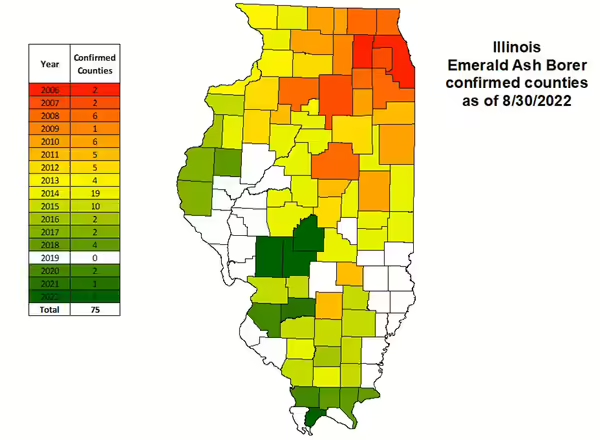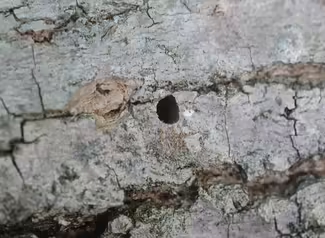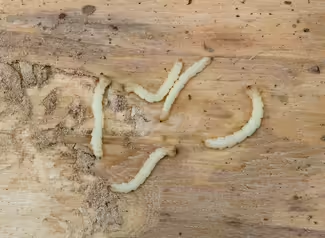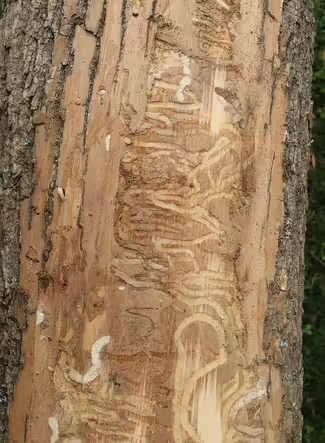
Emerald ash borer (Agrilus planipennis) is an exotic, invasive wood boring beetle in the Buprestidae family. Emerald ash borer, EAB, feeds exclusively on ash trees, Genus Fraxinus, with the exception of also feeding somewhat on the closely related fringe tree.
While the adults do feed on ash leaves, this is not seriously damaging to the trees. Female ash borers will lay their eggs on the bark of ash trees. The larvae that hatch then burrow under the bark to feed. Larval feeding is restricted mostly to the cambium and phloem, thin layers of tissue that lie just under the bark of trees. The larvae snake through the tree, just under the bark, creating winding paths, called galleries. As more and more beetles infest a tree, the feeding galleries disrupt the tree’s ability to transport nutrients and water, effectively starving the tree.
EAB, in its native range, is a secondary pest of ash trees, meaning that it only really attacks trees that are already stressed or dying from another cause. The story is different in Norther America. Ash trees here do not have any natural resistance or effective defenses. EAB acts as a primary pest, capable of attacking and killing otherwise healthy trees. In areas that have had EAB for a length of time, less than 1% of untreated ash trees typically survive. Trees infested with EAB typically take two to three years to die when smaller size in size but may take six to seven years to die when quite large.
All Illinois native ash trees are susceptible to EAB. When populations of EAB are at or near peak, most ash trees within the region will die within three to five years. This poses a threat to the health and integrity of natural forests, and also urban and residential forests, as ash trees are a popular landscaping tree. They were planted extensively throughout Illinois over the last 40 years, comprising approximately 20% of the urban canopy.

EAB was first identified in the U.S. in Detroit in 2002. It is estimated that it had been in the area for about a decade before being discovered. It was likely unintentionally introduced as a contaminate in wood packing material. Since that first discovery, it has spread to at least 30 states and two Canadian provinces. It is estimated that EAB has already killed more than 250 million ash trees in North America.
In Illinois, it was first found in 2006 in northeast Illinois, Cook and Kane counties. Since then, EAB progressed rapidly throughout the state and by 2016 has been found in 62 counties. EAB is a weak flyer, so on its own, the range would expand slowly. The reason it has spread so rapidly is because humans have moved it around, mainly by moving firewood or ash logs.
The most obvious outwards signs of an EAB infestation include dieback from the top of the tree and lots of small leafy shoots sprouting from the trunk, called epicormic sprouting. Woodpeckers often feed on EAB larvae, leaving many ragged holes and broken pieces of outer bark, making the lighter-colored inner bark more visible.
Larval feeding leaves winding channels, called galleries, under the bark. This can be visible by peeling loose bark off the tree or through cracks in the bark. After the larvae pupate in the tree, they chew their way out, leaving distinctive D-shaped exit holes.
The adults are not often seen, but are small, elongated beetles that are metallic green in color.
How to manage Emerald Ash Borer
You can effectively protect ash trees through insecticidal treatments. As long as the trees retain 70% or more of their canopy at the time of treatment, recovery is likely. Treatments are only effective for one to three years, depending upon the insecticide used, so repeat treatments are necessary.
Take the EAB Course
Learn more about EAB identification, impacts, and control options through a self-directed online course, available in English and Spanish. Users must create a free account to access the course.



